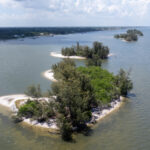SEBASTIAN — By the end of June, an experimental oyster farming project is expected to be in place at the Grand Harbor Spoonbill Marsh, made possible by oyster seeds and aquaculture equipment from Sebastian.
When county staff noticed oysters naturally thriving on clusters of rocks on the beds and banks at the marsh, veteran farmer Charlie Sembler of Sember & Sembler seafood company was brought in to consult on the job. He proposed a low-risk $15,000 test plan to get some oyster seeds planted and get the project underway. County Utilities Director Erik Olson said this test project, which Sembler will supervise for the first 90 days, will give the Board of County Commissioners the information they need to decide whether or not a larger scale project is warranted.
Why oysters in the marsh? Is this a scheme to raise and sell seafood on county land to offset the anticipated 9.5 decrease in property taxes next year? No, the oysters will not be harvested, but will become part of the marsh habitat.
The Spoonbill Marsh is a 67-acre facility designed to accept and naturally process byproduct materials from the county’s reverse osmosis system. Typically called “brine” but more precisely called “RO concentrate” this material cannot be directly discharged into the Indian River Lagoon. The marsh serves to recharge and filter the waste material naturally and oysters actually help by filtering the water.
“This is a one-of-a-kind project at this time and the Department of Environmental Protection is behind this as well,” said Art Pfeffer, project manager at the Spoonbill Marsh.
Pfeffer is also the person who first noticed the oysters in the water.
“I guess they got in there when we flooded the marsh with water from the river,” he said. “They just seemed to be taking to the rocks and that’s great because they’re such a good filter. The marsh is also full of crabs and mullet.”
The county contracted a firm to test the water and it was determined that farm-raised oysters would have a good shot at the Spoonbill Marsh.
With one of the goals of the marsh being to increase the diversity of wildlife, native plants and estuarine species present, the oysters seemed logical to officials.
The Marine Resources Council was also brought in to remove Brazilian peppers and other exotics and to plant natives that would enhance the habitat not only for the oysters but for the whole ecosystem.
Right now, metal construction studs which will become a dozen five-foot by five-foot frames to house the oysters, supported by chicken wire, are curing in salt water at Sembler’s Sebastian facility. In about two weeks, they will be brought out to the marsh and the oysters will be “planted,” according to Pfeffer.
Tiny Oyster “seeds” in mesh bags will be placed in the frames. The mesh bags allow water and nutrients to flow through to the oysters, but keep the oysters in one place until they’re larger so their size can be monitored. This also protects them from becoming food for other wildlife until they form their protective shell.
Pfeffer said Sembler will maintain the man-made oyster beds for a few months until the county decides whether or not it wants to invest more into a larger project.
“This is just something to get started, we didn’t want to go great guns at first,” Pfeffer said.






